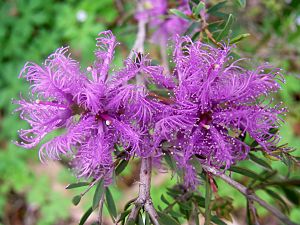Thyme honey-myrtle facts for kids
Quick facts for kids Thyme honey-myrtle |
|
|---|---|
 |
|
| M. thymifolia in the Royal Botanic Garden, Sydney | |
| Scientific classification | |
| Genus: |
Melaleuca
|
| Species: |
thymifolia
|
| Synonyms | |
|
|
The Melaleuca thymifolia, also known as the thyme honey-myrtle, is a beautiful plant from the myrtle family, Myrtaceae. It grows naturally in eastern Australia. People often notice this plant in spring because of its pretty purple flowers. It's one of the most popular Melaleuca plants grown in gardens. This fragrant shrub usually grows to about 1.0 m (3 ft) tall. It has bark that feels like cork and thin, flexible stems.
Contents
Discovering the Thyme Honey-Myrtle
The thyme honey-myrtle is a low, spreading bush. It can grow up to 1.0–1.5 m (3–5 ft) tall. It has grey, corky bark and smooth leaves. Its branches often arch over. The leaves are special because they grow in pairs, one opposite the other, and each pair is turned at a right angle to the pair below it. This makes them look like they are in four rows along the stem.
Leaves and Flowers
The leaves are small, about 5–15 mm (0.2–0.6 in) long and 1.0–3.5 mm (0.04–0.1 in) wide. They are flat and shaped like an oval, with a pointy end. Often, the top surface of the leaf is almost flat against the stem.
The flowers are a lovely color, somewhere between pink and deep purple. They grow in small groups, called heads. These flower heads can be found at the ends of branches, which sometimes keep growing even after the flowers bloom. You can also find them on the sides of the branches. Each head has 2 to 10 individual flowers and can be up to 25 mm (1 in) wide. Inside each flower, there are many stamens (the parts that make pollen). These stamens are grouped into five bundles, with 30 to 60 curved stamens in each bundle.
Flowering and Fruit
This plant flowers for a long time, mostly in spring. But you might see it blooming at other times of the year too! After the flowers, the plant grows small, woody, cup-shaped fruits. These fruits are about 3–5 mm (0.1–0.2 in) long and wide. They have five small, lasting teeth around their edge.
Naming the Thyme Honey-Myrtle
The scientific name for this plant, Melaleuca thymifolia, was first officially written down in 1797. An English botanist named James Edward Smith described it. He wrote about it in a science journal called Transactions of the Linnean Society of London. He noted that someone had given flowering samples of this plant to the Linnaean Society from the Chelsea garden.
The second part of its scientific name, thymifolia, is a clue about its appearance. It means "thyme-leaved." This is because the leaves of this plant look a lot like the leaves of the herb Thymus, which is commonly known as thyme.
Where the Thyme Honey-Myrtle Grows
You can find Melaleuca thymifolia in different parts of eastern Australia. It grows from Pigeon House Mountain in New South Wales up north to southeastern Queensland. There's also a separate group of these plants far away in the Carnarvon Range in central Queensland. This plant likes to grow in places that get wet sometimes, like seasonal swamps and along creeks. It can grow in many different types of soil.
Growing Thyme Honey-Myrtle in Gardens
The thyme honey-myrtle might be the most popular Melaleuca plant to grow in gardens. People love it because of its pretty flowers and its graceful shape. It can also grow well in many different kinds of soil and conditions. It can handle frost and dry weather, and it lives for a long time. However, it grows best when it gets enough water. Sometimes, it can spread out to 3 metres (10 ft) wide.
Gardeners have even created different types of this plant. Some popular ones include Melaleuca thymifolia ‘Pink Lace’ and Melaleuca thymifolia ‘White Lace’.

